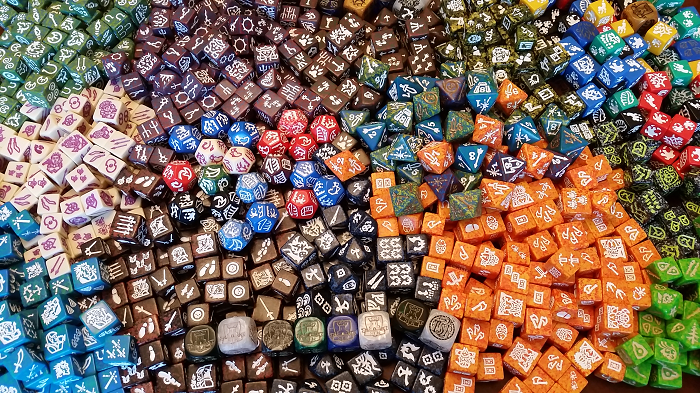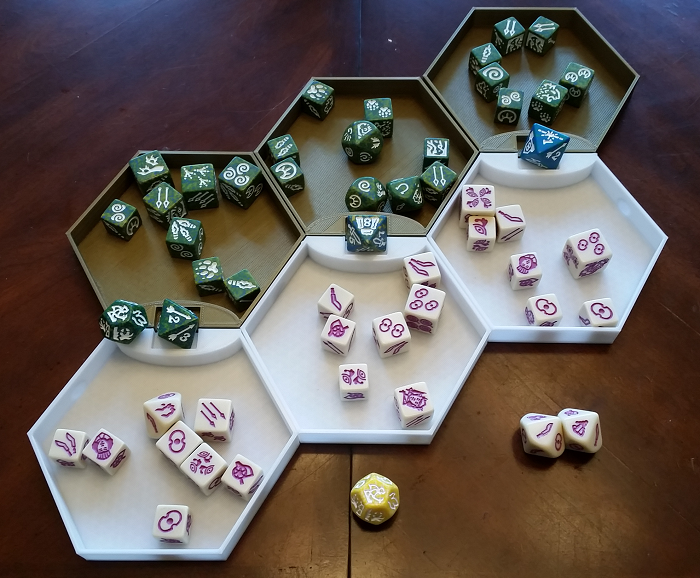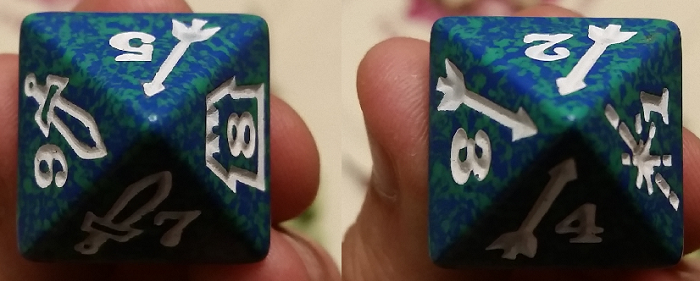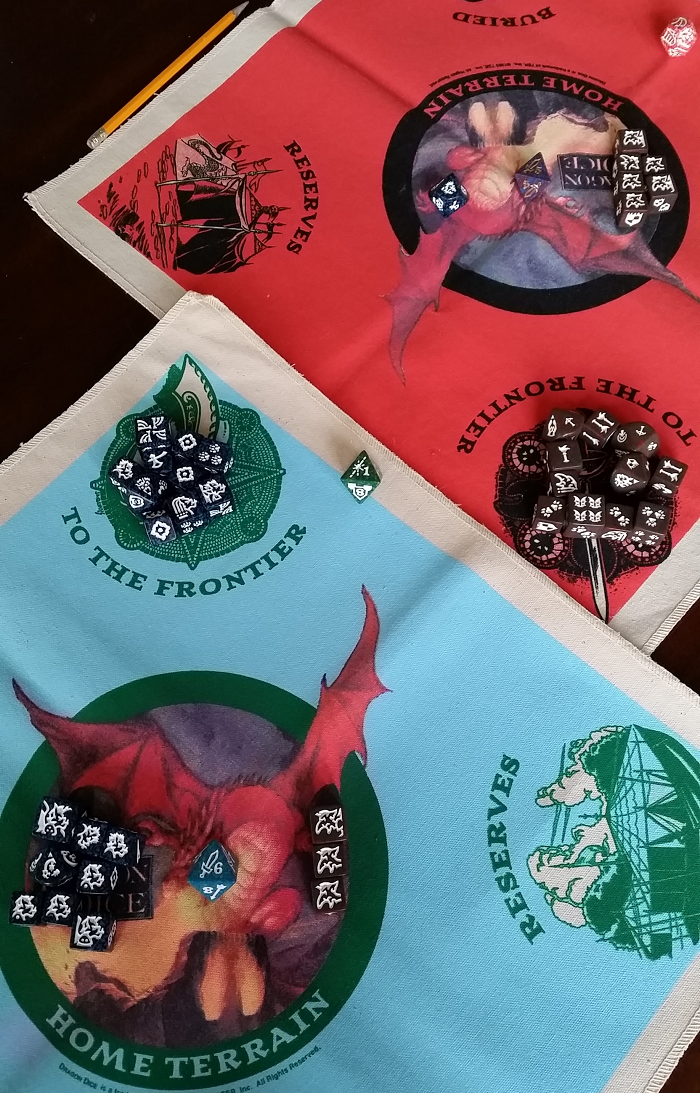
Dice Dice and More Dice
Introduction
Games are played in the contexts of rules, play, and culture. A game of chess played a century and a half ago would have a very different context and meaning between players than a game played today. Those players would be more likely to see one color of abstract playing pieces as Napoleon’s army. While I can imagine players today taking a more generic view of the pieces as something less meaningful to our historical context. The thread connecting the game today with the same hundreds of years ago is the rules–but even rules can change.
In 1995, my gaming group and I were eagerly anticipating TSR’s collectible dice game Dragon Dice. We were super-excited, having enjoyed Magic, The Gathering for several years at this time. We picked up starter sets, traded into the races that appealed to us (there were only four races at the time), spent a day playing, found the game extremely unbalanced (one magic-heavy player dominated every game), and never played again.
Fast-forward 22 years to 2017, where I pick up a copy of the Dice Commander’s Manual at a used book sale. In it I find five races I’d never heard of, but I also find that the game is still alive and well among a diaspora of fans online. I learn that, after TSR was bought by Wizards of the Coast, the company SFR literally saved the Dragon Dice inventory from being dumped unceremoniously in a landfill and continued publishing the game, revising the rules, and adding new races. Their gambit appears to have worked, because they have sold off and reprinted many dice over the years.
The Core Game
A fascinating dimension to Dragon Dice is how the game components relate to the rules. When SFR bought the game, they were buying predefined dice that were set in molds but the rules were completely malleable. The game has gone through several revisions since inception, with imbalances in each version making some races unplayable and others devastating. There are old forum threads filled with people complaining about how broken Amazons were and newer threads complaining about how useless they had become in newer rules versions.

Dice Trays my Wife Designed (Thingivers files here)
While the rules of Dragon Dice have undergone significant evolution, the core game is still the same. Players assemble armies to battle over three fronts of a war, two homes and a frontier. Each eight-sided terrain die represents how close the armies are to one another and what form of combat may occur. Armies far away from one another–represented with low numbers on the dice–may only use magic or missile attacks. As the armies close in to one another, they are drawn into melee combat. When a player maneuvers a terrain to the eighth-face, they win the terrain (for now) and take bonuses that come with controlling it. The first player to either maneuver two terrains to the eighth-face or wipe out the opposing army wins the game.
Different units specialize in different kinds of battle techniques, and that is where the game can get highly strategic. Your melee-heavy army might find itself helpless when your opponent maneuvers the terrain down to a missile face. What then? Do you withdraw and redeploy your forces, leaving that front unchallenged for two turns or do you stay and take the hits in hopes of maneuvering the terrain back to your advantage?
Basic Strategy
Here’s what I’ve learned about playing Dragon Dice in a few dozen games–mostly solitaire. Much of my advice probably isn’t the best, but it might give you insights to what is the best.

Terrain Dice
Chose Your Terrains: New rules have made this a little more straightforward. I used to struggle choosing terrains for my Amazons in 3.0. They got a great racial advantage in the flatlands, but those terrains were very magic-friendly when what I wanted was missile faces. I could count maneuvers as missiles at those terrains, but only have a two-in-eight chance of having missiles at all and a three-in-eight chance of pulling magic for armies weak in magic.
Control for Entropy: I have a hard time with army-building in this game. Dragon Dice are statistically complex. The rules help with this by organizing units along strategies like magic, missile, melee, and maneuvers, but it’s hard to evaluate similar units across races. There are trade-offs in probabilities as well. For example, monsters are extremely powerful, delivering four-points of results with each face, but with ten sides they are highly entropic. If you get what you want, it’s a powerful result, but you are also much more likely to whiff as well.
Rarity Balance and Damage: An army of three-health units will weather more damage without losing units, but an army of one-health units will deliver more consistent results. Several races recover units from the “Dead Unit Area,” so you will need a mix of unit sizes and plan to sacrifice them according to how they will return.
Watch Your Focus: A great tip from the strategy guide is to never concentrate all your forces in one army during the game. You’ll lose actions. Rather, seek to focus two armies on one terrain. Magic is often about influencing chance in your favor on future rolls. Having a magic or missile army heaping bonuses and damage on a neighboring terrain followed by the army at that terrain making a second hit is a powerful combo.
Melee or Maneuver is Mandatory: Because all terrains go melee before they reach the eighth face. Also, if your opponent has the eighth face, you will only have melee and maneuvering as an option. Either have an army ready to go hand-to-hand combat or an army that can maneuver the terrain to your favor.
Always Roll: A favorite adage of a grognard at my FLGS was, “Never roll dice unless you have to.” Since Dragon Dice is a dice-rolling game, I argue that you should throw that rule out. Always always always roll. Statistically speaking, each of us should, on average, experience a miracle once a month. With so many dice-rolls going on, your chances of a miracle go up the longer you play. So maneuver that one-health army against your opponent’s ten-points. You have a one-third chance of getting a maneuver and your opponent may bomb their roll.
Overall Impressions

Dice Faces: Maneuver, Missile, Melee, Magic, and Save
SFR has done some amazing work with these game components. I love how they have kept the game alive through persistent work and refinement. The fourth edition rules have really smoothed out the game’s previous imbalances. Most notably, it eliminated my least-favorite game mechanic, doubling of ID magic results at terrains. There was nothing more devastating than a 12-point Firewalker army dropping 10 points of damage thanks to 22 magic points. Now, powerful racial abilities have caps, like Lava Elves getting unsavable damage–but only up to three points.
These kinds of limits prevent overwhelming imbalances that made games feel predetermined in previous rules editions. Now, games often don’t go the way you expect them to based on the opening setup. I’ve seen armies in terrible opening conditions completely reverse the odds and stage epic comebacks. It’s always worth it now to hold on and work for things to turn around.
While many gamers hate games heavily reliant on luck, in the case of Dragon Dice I find it quite liberating. Whether the odds are stacked for or against me, I feel completely relaxed every march knowing the results are beyond my control. I’m working the odds as best I can, but statistically I shouldn’t be surprised when I completely whiff. The game combines intense strategy with luck in a balance that makes my games stress-free and oh so enjoyable.

Setup on Old TSR Playmats
My only remaining complaint about Dragon Dice is that it still hasn’t overcome its grognard origins. This is still very much a game from the days of memorizing hundreds of pages of rules errata before you can play. Even after dozens of games, the flow of my play keeps getting interrupted as I flip through the rulebook to look things up. I counted 135 special action icons (SAIs) in the rulebook, many with fairly nuanced rules. Games like Dice Masters and Star Wars Destiny overcome this icon-overload with rules on cards. It’s possible that reference cards for dice with the faces could make the information-overload less overloading. Additionally, playing with just basic components helps as well.
When the game is flowing thought, there is a frenetic energy to this game that I just love. Players are rolling double-handfuls of dice over and over again, sorting them, counting out the results, and comparing. It’s pleasantly loud and involves perpetual tabulation. Games feel shorter than they actually are because the play area demands constant attention.
Finally, the theme of the game is wonderful. Your small units form a well-focused hoard that dies in droves, while your monsters are wild unpredictable beasts. Terrains are a fantastic mechanic that let you imagine your armies getting closer and further apart with each turn of the face. Artifacts, dragons, and dragon kin also add rich flavor (and complexity) to the game.
Dragon Dice presents a clever and unique gaming experience. One rich with history and rules that benefit from decades of refinement through a cult-following of devoted players. I’m glad to have rediscovered the game and its rich culture. I look forward to years of playing and new developments to come.